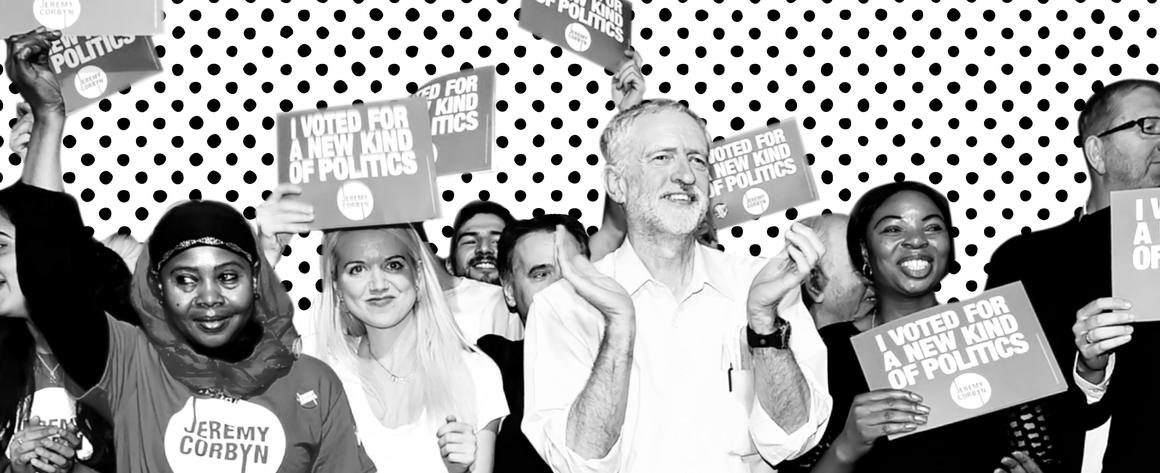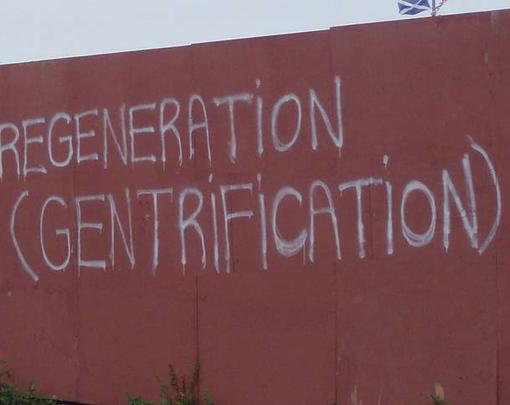From the town of Preston in the United Kingdom to the streets of Cleveland, Ohio and New York City, a new economics is emerging that is grounded in alternative models of ownership, ranging from city-level community wealth building to large-scale public ownership at the national level. This June 3, 2018 Left Forum panel discusses what the US Left can learn about how to build a popular economic agenda that can challenge corporate capitalism. Participants are Ted Howard, co-founder and president of The Democracy Collaborative; Hilary Wainwright, a leading researcher and writer on democratic accountability efforts around the world; and J. Phillip Thompson, the New York City deputy mayor of strategic policy initiatives and an associate professor of urban studies and planning at MIT. This is a partial, edited transcript.
People-powered economics, from Cleveland to Preston, England
Ted Howard: Something remarkable is happening in the UK. The Labour Party under Jeremy Corbyn is, with the support an energized grassroots base, articulating an economic platform that breaks neoliberal orthodoxy to outline what an economy that works for the many, not the few, could look like. This new economics is grounded in alternative models of ownership. and it’s really both building from the ground up in the community wealth building frame and looking very much at the national level and how to democratize large-scale public ownership and the like. This is really quite an extraordinary economic agenda that is being developed right now in the United Kingdom.
Let me tell you about community wealth building. This is a term of art that we created in about 2005 as a challenge to how economic development is typically done in cities in states. Mostly, what we have now is every city in America is at war with every other city, and same with states. Over $80 billion a year of public money is spent in the United States to provide all kinds of incentives to corporations to move them around.
I live in Cleveland, Ohio. In Cleveland, the Department of Economic Development thinks it’s a great victory if they could put together several tens of millions of dollars of subsidies and seduce a company to leave Milwaukee and throw 200 people out of work there but bring 200 jobs to Cleveland. Except these companies aren’t really loyal to the community. They really only came for the subsidies and tax breaks. Six years later, when the subsidies sunset, they pick up and off they go to North Carolina or somewhere. We said this is literally insane and it’s not changing the dynamic in our communities, so this idea of community wealth building is focused on building collaborative, inclusive, sustainable and democratically controlled local economies. Part of the way to do that is to build the kinds of structures that embody those principles, like worker cooperatives, credit unions, community development financial institutions, community land trusts, municipal-owned companies and companies owned by the city government.
These became very, very important parts of creating an ecosystem in which these principles of community wealth building can take hold and be expressed, and very importantly, to root these businesses, their capital and these jobs in the communities so they don’t get up and leave.
A lesson from Mondragón
I was just in Mondragón, Spain two weeks ago, where some 75,000 people democratically own a network of over 100 worker co-op businesses that is turning over something like $22 billion a year in revenue. They have the third largest bank in Spain, the seventh largest corporation in Spain.
I asked them what did they think the distinction was between what they’re doing and what we do in the United States. Just how were they contracting, because in one sense, they’re working in the market and they’re for-profit businesses? They’re exporting products, and somebody said they have CEOs; they look like companies we’re familiar with. What they said was really, what the first principle is here, and the way they put it is, in your system: in your American corporate capitalism, capital is always in first place over labor. When your companies get in trouble, the logical thing to do is fight as hard as you can to preserve the capital, and one of the ways you do that is you often let as much labor go as possible to save money. In our system in Mondragón, we believe labor should be in first place over capital. We know capital is essential—we can’t have a business without capital—but the goal, if we get into trouble, is to keep people working, not to shed them.
Then the way we do that, we have strategies to do that where more successful worker co-ops will absorb some of the members of the less successful companies. People on the shop floor might get together and say, “We want to keep all of our brothers and sisters working so we’re going to voluntarily cut back our hours to 32 hours a week for the next five months to save the money to keep people working. Such a very different design principle.
There are two flagship models of community wealth building that I’d point to. One is in Cleveland, Ohio. In Cleveland, starting about eight years ago, The Democracy Collaborative, along with the city government, the Cleveland Foundation and some of the big anchor institutions like the Cleveland Clinic and Case Western Reserve University, created a community wealth building strategy designed to put people to work in very low income, disinvested neighborhoods.
Many people have serious barriers to employment, which is the euphemism for, may have been incarcerated, may have dropped out of school in the eighth grade and so forth. It’s hard for them to get into the labor market, particularly if they have a felony record. The principles we used were to leverage the purchasing power of these large universities and hospitals in our community that every year purchasing over $3 billion a year of goods and services, except they’re surrounded by six neighborhoods with 50,000 residents whose median household income for a family of four is $18,500. The federal poverty line is about $22,500. You’ve got $3 billion churning around in this zone in the city surrounded by this great sea of poverty and disinvestment. Part of the strategy is, how do you take that money that’s going to be spent anyway and drive it into the community. Then we said, if we’re going to drive that money into the neighborhoods, let’s drive it to new businesses that are rooted in the communities where people work; where people could literally walk to work if they didn’t have transportation.
Companies that are employee-owned, we created them as worker co-ops, and the theory that a job alone is not enough. You’ve got to have a job and a way to build assets and wealth, and if you own a stake in the company, you’re, in effect have profit sharing. It’s not called that in the cooperative but it’s the same principle where your labor contributed to the profit and therefore you get to participant in it. We wanted these companies to be the greenest in their sector that, if you’re doing business with an evergreen cooperative, you’re doing business with a green company that can help you as an institution achieve your institutional goals.
Assets for grassroots revival
Cleveland 50 years ago was a city of 918,000 people. It was one of the five wealthiest cities in America. It had more Fortune 500 corporations headquartered in Cleveland than any city except Manhattan. Now there are two Fortune 500s left. The city population has gone from 915,000 to about 390,000, and Cleveland is always rated the second or third poorest city the country. The level of disinvestment in the industrialization has been enormous. The assets that were left behind in this process are these large hospitals and universities: multibillion-dollar world-class institutions but their economic power is leaving the region. They’re buying stuff from everywhere but not locally. We said, “Let’s localize it.” So, we’ve got three companies up and running. We have a year-round hydroponic greenhouse based in downtown Cleveland, worker-owned. We have a renewable energy company doing work with all these large institutions and we have laundry services.
One company employs 50 people and does 8 million pounds of healthcare bed linen. At Cleveland Clinic, all of its over 22 million pounds of laundry had been done for last decade by Sodexo, which is a multinational corporation based in France. But when you talk about extraction of wealth and money from the community, imagine getting your laundry done by a company that’s not even located in the community; it’s extracted. The Cleveland Clinic became convinced that our strategy for community wealth building made sense in many ways including helping them achieve a healthier population in the community, and so they just terminated the contract with Sodexo and transferred all 22 million pounds into a huge laundry facility over to Evergreen. Overnight, we added another 120 workers to the worker co-op who are now being integrated. That’s a wonderful thing.
We’re trying to build this cooperative community of businesses in Cleveland, and we’re hoping to create a network of these. Some of these cities have really moved forward on these strategies: Rochester, New York and Richmond, Virginia have offices of community wealth building that their mayors started that promote all of this kind of equitable inclusive economic development. In Albuquerque, New Mexico, a group at the city government, the public school system, anchor institutions, the community foundation have started something called Healthy Neighborhoods Albuquerque that again is using purchasing power to build up the local food system, build cooperatives and et cetera.
The call from the UK
In 2012, I got a call from somebody in Preston, England, which, not to my credit, I had never heard of really, but I’m sure many people in England have never heard of Cleveland either. They said, “We have been following your activity in Cleveland for the last few years, and would you come here to Preston because we want to do something similar. We’re a city that is kind of flat-on-our-back in terms of the economy.”
They were working for many, many years to have a £700 million investment in a big retail enterprise come into the city, and that blew up. So, that’s £700 million of investment disappeared. Meanwhile, their government is imposing an austerity program and so their budgets are going down, down, down. What happens, Matthew Brown and his colleagues on the Labour-dominated City Council started something that in the Guardian newspaper, the Economist and the Times of London is now called the Preston model.
What’s interesting to me about the Preston model is it’s far more robust and far more multidimensional than anything that’s been contemplated in Cleveland or any city in America around these wealth building strategies. They’ve lined up six of their anchor institutions to begin purchasing locally and these include such entities as public housing authorities, the University of Central Lancashire and the local police authority.
In the last few years since they’ve begun, they’ve been able to repatriate or bring back £70 million of contracts that used to leave the Preston economy. Now, this is a city of about 150,000 people; £70 million of new money coming in is substantial, so that’s one thing they’re doing. They’ve set up a cooperative development center at the University of Central Lancashire because at £70 million is basically going to exist in small businesses in Preston, but they also want to build up worker ownership. They’ve got an incubator for what they call gap co-ops, looking at where are there things that institutions may want to buy but they don’t exist in the local market yet. The first two co-ops are being spun out. They’re looking at establishing the Public Bank of Lancashire that will be capitalized by the reserves of the City Council and the County Council so that they would have their own source of capital that’s loyal and committed to Preston and to Lancashire.
They’re exploring the creation of a city-owned green energy company. They are now in the process of using up to £100 million pounds of public employee pension funds for investment in student housing and other kinds of local investments. You’ve got this really multidimensional strategy that’s happening, and as a result, wages—and the data has been done—have risen in Preston. In England, they have something we don’t have in this country called the deprivation index. Preston’s status on the deprivation index has changed considerably as things have improved. In one recent poll, Preston was voted the best community to live in Northwest, England. I think now it’s not all because of this strategy, but this is part and parcel of reinvesting in Preston.
Finally, Labour at the national level has really taken notice of what’s taking place in Preston. Jeremy Corbyn, the head of the Labour Party, has in his office established a community wealth building unit that is going to be training City Councils all over the country to begin to do the kinds of things that happened in Preston. It’s a very exciting moment right now, I think, to begin to bring about systemic economic change at the local level, even as also Labour is looking at much bigger-order changes.
Seeds of community wealth building
Hillary Wainwright: E.P. Thomson, in The Making of the English Working Class, quoted a London artisan who was also a historian who said, “People fancy that when all is quiet, that all’s stagnating.” But actually, it’s when all’s quiet, that the seeds are growing. I think that’s what’s been happening. In Britain, the left has been quite influenced by thinking socialism is hegemonic, as they say. We got to, “just can’t do anything.” The sorts of people who want to do something pragmatically go along with the tact-right consensus, like Tony Blair did. Some kind-of-good people went along with him, thinking, “Okay, we’ve just made things a bit better.” And other people tear each other to bits, as often happens on parts of the left.
Actually, what was happening was all kinds of resistance, but it was resistance that was also developing alternatives. It’s out of that, that this new economics has emerged. I might just say something very quickly about these forms of resistance that have been the seeds that have been growing and the alternatives that are coming out of them. Then, I’ll say something about the mentality and thinking of the new Labour leadership, which is very open to that resistance and very different from the highly parliamentalist tradition of Labour politics. Then I will try and say something a bit analytic, generalizing from these experiences and how the Labour leadership is attempting to think about the macro-national implications of that. Then, maybe I will say something briefly about the obstacles and then the potential.
In terms of the kinds of resistance that have been emerging, firstly, it began with local government and the very strong trade union movement. I used to work for the Greater London Council, the governing body for London before it was abolished by Mrs. Thatcher. I was the founding thinker of the popular planning unit. Now, budgets were in the millions, which I wasn’t really used to dealing with. Anyway, it illustrated the idea of using local government or a political office with an election mandate not simply to manage the status quo but to be a form of resistance that was developing alternatives. That, in a way, is what Preston is doing, and in a way, John McDonnell himself, the shadow chancellor, which means he is the economics minister-in-waiting and therefore close to Jeremy Corbyn.
I think that experience has made him very open to the possibilities of municipal initiative. But there, we did a lot of the things that now Preston is doing. We use public procurement as an economic instrument to bargain with local companies to pull up wages and support the training of minorities and women. We also developed our own investment bank, The Greater London Enterprise Board, which would use funds to take over companies that are collapsing. This was in years when basically Thatcher oversaw a de-industrialization of Britain that was beginning before she abolished the GLC. Then we created this popular planning unit. The principle there was the knowledge that the basis of alternative thinking in any socialist strategy lay with working people of London.
The point of this popular planning unit was not to simply draw up plans and then consult in the old tradition where local government draws up its plans, organizes meetings in schools and community centers, expects people to come to it, and then tick what people like or don’t like. But this was saying, “No, actually people are creative.” And we were inspired by very significant experience in Britain.
‘Hey, we’re not redundant’
There was this very important campaign supported by Tony Benn, who is a leader of the left. Basically, there were these workers in a company called Lucas Aerospace, which was in arms-producing, missiles and stuff. They were faced with redundancies, de-industrialization and corporate rationalization. The managers said, “Look, we’re going to have to consider you redundant. This factory will be closed.”
The workers were highly skilled, highly self-confident designers and engineers. This was in the early 1970s when the labor movement in Britain was very strong, very confident and also very organized across unions. They have a kind of autonomy from the national officialdom. They had day-to-day control over production. They could determine the pace of work, the conditions of work. They said, “Hey, we’re not redundant. We needn’t just be producing missiles.” They knew they could be producing all kinds of things.
Tony Benn, after the Labour government has been elected in 1974, asked them, “Well, what do you want me to do? Do you want me to nationalize the company or what?” They said, “Well, nationalization hasn’t worked for us. We have the the national coal board, and we saw the closure of the mines and those railways which were closed; all the rural railways were closed. So, nationalization isn’t what we’re thinking about, or at least, not as it’s been. We think we need to develop our own plan, and then nationalization can be on the terms we set out. But it’s got to be our plan. We’re not going to participate with management.”
So, they went away back to their workplaces; they were very democratic, formed what was called a combine committee that brought together shop stewards from offices and the factory floor, and then brought them together across the whole company. They built up this combine committee, and first did an audit of what the capacities and resources of the factory were in terms of machinery and skill. Then they’d say what they thought they could be producing: alternatives to missiles. It was a whole new mentality.
I worked with them, wrote about them and the amazing things they were saying: “We never thought like this. This is … We never thought of ourselves as planners.” Here they were developing this plan. I think, here, there is a very important lesson about the knowledge of what’s involved in a different kind of planning. They would say, “Our knowledge is tacit knowledge often. We can’t necessarily write it out, but we can produce.” So, it’s part the campaign. They actually produced the alternative. They had that idea of a road/rail vehicle that could go from road to rail by various contraptions that they designed. Then, they took this on agip-prop tour explaining what they were doing and explaining this product. There was also a product around energy conversion and around medical equipment. It was a whole ecological plan as well. They called it a plan for socially useful production.
Anyway, this inspired us at the GLC, the Greater London Council, so we said we’re going to give resources, including time off for both workers and communities, to develop alternatives which then we through the investment board would support. This was a seed that was growing beneath the surface.
Pushing back against privatization
Another kind of seed was growing at municipalities and the health service, where privatization was beginning to be the norm and even the audit commission, which is meant to be some neutral governmental body, actually made outsourcing a kind of part in a market-led definition of efficiency. I remember a shop steward rung me up and said, “We’re facing new rationalized privatization. We think we should do a workers’ plan. Why don’t you come and have a look?”—meaning, something like the Lucas Workers because it had inspired people, particularly strong trade unionists. They thought, “Yeah, we’re not just about defending wages and conditions, we’re also about an alternative. The Labour isn’t giving us an alternative, so let’s develop it ourselves.”
in this municipality in Newcastle, they said, “Look, the IT system was totally inefficient, but the municipality was just voting it through, agreeing to it and then building up huge bills.” Management was saying, “This is impossible. We can’t do anything about it. Let’s hand it over to BT, to a private company.” The workers were saying, “Hang on a minute. Actually, we know how to make this more efficient. We actually produce this technology.”
It was left to the trade union. They then developed an alternative, again, drawing on their knowledge and valuing the union as a way of socializing this practical and tacit knowledge, and developed an alternative. In the end, finally, they blocked BT.
Then they had a whole restructuring plan based on the workers proposals with management supporting them and made huge savings of around £28 million that was then devoted to old people’s care and youth services. That’s when I first saw the relevance of that concept of public value, because they were making savings because they could see how things could be different. They had an agreement with management that there be no compulsory redundancies. They did actually then produce these savings, which were of public benefits, so they maximized public benefit as distinct from profit. That was another kind of model.
Leadership open to alternatives
Then, we have the growth of the cooperative sector and the emergence of social enterprises that have emerged out of a whole new generation that is actually bothered about the nature of their food or they’re worried about climate change so they’re concerned about energy, about recycling. Others have been developing collaborative enterprises, not always cooperative because sometimes, in the neoliberal climate, the institutions of the labor movement like the cooperative movement are not really even know about let alone part of school education and so on. People have just developed enterprises, but of a social kind. And all over Britain, there are all kinds of very imaginative things, like in Oxford, an alternative brewery called Tap. It creates this sort of social hub as well, and they see themselves as very political and very transformative, but they are an enterprise. So, that’s another thing that’s emerged and we need to think about how to build on that.
The thing about Corbyn, et cetera is that they’re exceedingly open to all this. They’re completely different in their thinking from the old paternalistic leaders of Labour. Corbyn has been so popular partly because everybody, and I’ve done a lot of interviews on it, everybody will say things like, well, we’re desperate for an alternative, and when we saw Corbyn, we just knew that was the one because he’d been to our protests, he’d been on our picket lines. He talks about his view of knowledge: “I never held in awe those who had higher education”; some of the wisest people you meet are sweeping the streets. And he just gave, as an example, a friend of his who lives in an incredibly sort of consciously ecological way because of his awareness of climate change. At the same time, he’s a street sweeper, but he’s got this practical knowledge of ecology and of the whole kind of system that’s destroying our planet. Corbyn’s whole appeal, is he’s not saying we know what’s to be done. He’s saying, “I’m listening to you. What are you doing, how can I support you?”
All these things that I’ve mentioned: workers, trade union, plans, cooperatives, municipal initiatives, what they have in common is the resistance to austerity, neoliberalism and market-led economics. They’ve all got this belief, whether they’re consciously or unconsciously, in the importance of public value, so they’re not denying the importance of creating wealth, but they see that in terms of public value. So in the Great London Council, for instance, we saw in the whole area of domestic labor, economists Sheila Rowbotham and other feminists who were running our industry policy. Our industry strategy had a whole section on domestic labor, which included childcare laundry. When it comes to Corbyn, they were very responsive to all this, and we have this amazing launch of their new economic strategy and there are new forms of public ownership.
I’m just going to quote John McDonnell quickly because he can say it better than me. He says, “We need to do better than reinvent the past. … We should not try to recreate the nationalized industries of the past. We cannot be nostalgic for a model whose management was often too distant, too bureaucratic and too removed from the reality of those at the forefront of delivering services. … Taking essential industries away from the whims of the market is an opportunity to move away from profit as a driver of investment. But just as importantly, it’s an opportunity for us to put those industries in the hands of those who run and use them. To learn from the everyday experiences of those who know how to run our railway stations, utilities and postal services. That’s what’s needed by their users. But then finally, our socialism has never been about public ownership for the sake of it, but because we believe that nobody know better how to run these industries than those who spent their lives with them either working or using them.”
The creative capacity of communities
So, that’s the sort of logic behind this thinking. There are people from the unions, from local authorities, from co-ops, from social enterprises and from also academia. This community wealth building structure is about drawing them into the production of public value and turning them into a resource and a support for the creative capacity of communities. Preston is one example. I went there just to sort of check it out, and what I was impressed by is they’ve also created a whole different mentality among people, particularly among trade unionists. I talked to people in the local hospital who just were glowing from a small victory of just stopping the privatization of the cleaning of medical equipment, and they were just saying, again, like the workers in Newcastle, “We know how to do that better. We can improve its public benefit.” They can be more publicly efficient, and then they mobilize both the community and the workforce to block privatization—and also enhance the social democracy of how the public sector was managed. That’s key to this community development idea.
I just want to stress that spreading this is not just spreading what the municipality can do but creating an example of valuing the public so that citizens and enterprises actually begin to organize differently. I think it’s really important to identify the power that a municipality’s elected government can have and the distinct power of the people and their power of transformative capacity, that is, the power of people discovering together their capacities to create.
I think what’s happening is a spread of this Preston model with the help of The Democracy Collaborative, and I think this is especially important for the possibility of the Labour government because it’s by no means automatic. The Tories are not only absolutely focused on power, they’re divided but they’ll ultimately find a way of uniting to stay in office, which they feel is their entitlement. They do feel they are the ruling class. Second, in the press in Britain, there’s no space for the left. There are a few left journalists, but in the time that all these new ideas were being launched, the press was focused on Jeremy Corbyn being an agent of the Soviet Union and the like. Hardly any of these alternatives get any airing. This is the public media, the BBC, but that then sets the agenda for the Times, even the Guardian. There is a bit of publicity for this but it’s not seen as mainstream because one journalist will make a story of it, not because it’s seen as news or is important. Developing this propaganda by example is crucial because It’s the truth; it’s in people’s daily lives.
I think it’s really important to develop a politics in which economic initiatives are seen as a key part of political campaigning. I think we have to develop this. There’s a lot of emphasis on participatory democracy, but we have to see that as productive democracy, that these initiatives are about creating a different understanding of value to what’s dominated the neoliberal agenda.
New York City’s investments in people
J. Phillip Thompson: I will say a few things about what we’re up to in New York. There are a number of initiatives that I don’t think really get much credit as being part of economic democracy but I think are. I was mentioning one early, universal pre-K. There are mostly low-income women spending $2,000, $3,000 a month, many of them for private quality daycare for their kids so they can go to work. That’s more than half their income in many cases.
Having available quality preschool for their kids is like an enormous boost in their income, more than any labor union delivered in a contract negotiation, more than the minimum wage of $15 an hour. It’s huge. Things like that are happening that folks don’t pay much attention to, or see in the context of conversations like this, but I think that’s a mistake. There are a number of things like that happening.
One of the biggest challenges in low-income communities right now is actually the stress, and the problems that are accumulating from that stress. When you’re paying 50 percent of your income for housing, what that does to daily life and people’s ability to cope, because it means you have nothing for anything else. When we go around and talk about the Thrive Initiative, which is a billion-dollar community mental health initiative, we are basically saying come out in the open. Let’s talk about what’s going on in our families. Let’s talk about what we’re struggling with. Let’s help each other with that. The outpouring has been enormous.
Also, on very basic things like having the truth of your lives recognized in public by a president who lies about everything and a government you can’t even count on to do a census without lying. You were talking about a press that doesn’t tell the story of the American people. For those who are really suffering, that contributes to mental illness, when you can’t validate what’s happening in your life experience—this whole celebration of stop-and-frisk when Bloomberg was mayor, when folks were going crazy being harassed day in and day out; parts of Manhattan say it’s very rare, everything’s fine and you go in another area it’s a police state. It’s been like that here.
A number of the things the city has done before I got here were really focused on trying to address these issues that are coming from communities. I feel if we don’t address these issues, we don’t get to these other issues. If someone is struggling with these problems, they don’t get to sit on the co-op board and decide how to run a company; it’s not going to happen.
Organizing and empowering consumers
One thing we did last week we have a RFI out—a request for information, like an RFP or request for proposals—to put a chip on the NYCID card. The NYCID card was created by the mayor’s office of migrant affairs. We have over 3.5 million immigrants in New York. Millions of them can’t get a driver’s license, et cetera. The idea of putting a chip on the card is to enable online banking. The vast majority of these folks are low-income people and do not have access to a regular bank account. They use check cashing places and payday loan shops. On average they get charged 400 percent annualized interest. They’re spending close to 10 percent of their annual income on finance fees, which is as much as they spend on food.
Having access to online banking, where you can negotiate your rates and have transparency, could be a significant immediate financial help to many folks. In Boston I did an experiment like that with the Homecare Workers Union, MasterCard and a credit union based in Minnesota, in reaction to Harris v. Quinn, the Supreme Court ruling attacking home care workers unions. We get data on whatever you want to buy, so step two will be organizing consumer bargaining groups. I call it community collective bargaining which has been stamped out in this country since the 1947 act that prohibited unions from engaging in activities like consumer organizing and boycotts.
We did an experiment with the public housing residents in New York 11 years ago. Mayor Bloomberg allowed me and a team to go to housing residents and we asked them, could we represent you to buy cable service collectively for 200,000 households. We tested it, and we got offers of $32 million a year from cable companies going to the residence associations if they would agree to a collective contract. Then the guy who did it and was leading our team, Randal Pinkett, went on The Apprentice. He’s the first black guy to win The Apprentice, and went off to build a hotel with Donald Trump in New Jersey and that was a total disaster. Then Katrina happened and I spent the next couple of years dealing with that in New Orleans. We didn’t follow up but these things are even more ripe now. Bernie Sanders did this consumer bargaining when he was mayor of Burlington, Vermont over diapers with low-income folks.
We think there’s an opportunity there to find new ways to fund community organizing, civic engagement, even politics, through consumers being better organized and leveraging their power in the market that way. There were 700,000 New Yorkers last year who didn’t fill their prescriptions because they were too expensive. That’s something we all pay for, so why not organize and leverage our muscle now?
Steps toward economic democracy
Our school system buys 190 million meals a year from folks like Sodexo and others. We’re now in conversation with four other of the largest school systems on how can we leverage our food purchasing in all the ways that you’ve been talking about. There are 11,000 nursing homes in New York. The majority are now private. The nonprofits don’t want to sell out to the privates because they think it results in basically laying off workers and not enough staff to take quality care of people. SEIU Local 1199 wants to look at buying cooperatives, leveraging their pension funds, and turning them into worker co-op nursing homes. That’s one of several initiatives some of the unions are considering. They’re also considering forming their own home care companies.
We’re just starting on the process, so what’s a sustainable model for doing those kinds of investments? Because these pension funds are people’s savings. We had one victory fighting the closure by the state of Interfaith Medical Center three and a half years ago, and now to the coalition that won that victory the governor handed over two more hospitals. There’s an emerging hospital network in Brooklyn, called One Brooklyn, run by the first African-American woman head of a hospital in the history of New York state, Dr. LaRay Brown. She’s all in for pursuing these new kinds of strategies. We’re talking about opening a furniture factory to make hospital furniture in New York which will be a worker-owned furniture factory and from there maybe going to appliances and maybe other things.
Last thing, we’re expanding our Democracy NYC initiative or at least internally, we have to include the concepts of economic democracy, expanding people’s awareness of alternatives to ownership like cooperatives, consumer organizing and bargaining. We’re getting into things like the new platform economies, and what public power and ownership looks like when you’re talking about Google, or Uber or the platform companies. Also, what about our rights as shareholders? Many of us own shares in Wall Street or public companies but I don’t remember progressives ever organizing campaigns for the board of director of Citibank or the car companies the way we do for mayor or governor, but it’s our right to do so. The thing is, no one will develop your curriculum or training or modules nr how to do that if we don’t do it. Wall Street is not going to do that for us.
We are making that part of our economic democracy learning process and also advocacy as we do Democracy NYC, in which we’re hoping to reach millions of New Yorkers talking about civic engagement and democracy, and defending the rights of immigrants and other marginalized people.






